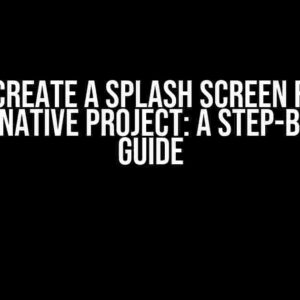Are you tired of static and boring UI components? Do you want to add some life to your React application? Look no further! In this article, we’ll explore the basics of creating stunning transitions with React-Spring, a powerful animation library for React. Specifically, we’ll dive into creating a basic transition that solves the common issue of the background appearing before the component is rendered.
What is React-Spring?
React-Spring is a popular animation library for React that allows you to create stunning animations and transitions with ease. It’s built on top of the Web Spring Animation API, which provides a robust and performant way to animate web applications. With React-Spring, you can create complex animations, transitions, and even gestures with just a few lines of code.
Why Use React-Spring?
There are several reasons why you should consider using React-Spring in your React application:
- Easy to use**: React-Spring has a simple and intuitive API that makes it easy to create complex animations and transitions.
- Highly customizable**: With React-Spring, you have complete control over your animations and transitions, allowing you to create custom effects that suit your application’s needs.
- Performant**: React-Spring is built on top of the Web Spring Animation API, which provides a highly performant way to animate web applications.
The Problem: Background Appears Before Component is Rendered
When creating transitions with React-Spring, you may have encountered a common issue where the background appears before the component is rendered. This can be frustrating, especially when you’re trying to create a seamless and smooth transition.
This issue occurs because React-Spring applies the transition styles before the component is rendered. To solve this problem, we need to find a way to delay the application of the transition styles until the component is fully rendered.
The Solution: Using useSpring and useChain
The solution to this problem lies in using the `useSpring` and `useChain` hooks provided by React-Spring. These hooks allow you to create a spring animation and chain multiple animations together, respectively.
Let’s create a basic transition that solves the issue of the background appearing before the component is rendered:
import { useSpring, useChain } from 'react-spring';
function MyComponent() {
const [show, setShow] = useState(false);
const spring = useSpring({
opacity: show ? 1 : 0,
transform: show ? 'translateX(0)' : 'translateX(-100%)',
config: { duration: 500 },
});
useChain(show ? spring : []);
return (
{show && Hello, World!
}
);
}
In this example, we use the `useSpring` hook to create a spring animation that controls the opacity and transform of our component. We then use the `useChain` hook to chain the animation to the `show` state. This ensures that the animation is only applied when the `show` state is true.
Notice how we also use the `backgroundColor` style to set the background color of our component. We set it to `rgba(0, 0, 0, 0.5)` when `show` is true, and `transparent` when `show` is false. This creates a smooth transition between the two states.
Step-by-Step Guide to Creating Basic Transitions
Now that we’ve solved the issue of the background appearing before the component is rendered, let’s create a basic transition that demonstrates the power of React-Spring:
Step 1: Create a New React Component
Start by creating a new React component:
import React from 'react';
function MyTransition() {
return (
);
}
export default MyTransition;
Step 2: Add State and Animation Hooks
Add a state and animation hooks to your component:
import { useState } from 'react';
import { useSpring, useChain } from 'react-spring';
function MyTransition() {
const [show, setShow] = useState(false);
const spring = useSpring({
opacity: show ? 1 : 0,
transform: show ? 'translateX(0)' : 'translateX(-100%)',
config: { duration: 500 },
});
useChain(show ? spring : []);
return (
);
}
Step 3: Add Transition Content
Add the transition content to your component:
import { useState } from 'react';
import { useSpring, useChain } from 'react-spring';
function MyTransition() {
const [show, setShow] = useState(false);
const spring = useSpring({
opacity: show ? 1 : 0,
transform: show ? 'translateX(0)' : 'translateX(-100%)',
config: { duration: 500 },
});
useChain(show ? spring : []);
return (
{show && Hello, World!
}
);
}
Step 4: Add Trigger and Animation
Add a trigger to toggle the `show` state and an animation to your component:
import { useState } from 'react';
import { useSpring, useChain } from 'react-spring';
function MyTransition() {
const [show, setShow] = useState(false);
const spring = useSpring({
opacity: show ? 1 : 0,
transform: show ? 'translateX(0)' : 'translateX(-100%)',
config: { duration: 500 },
});
useChain(show ? spring : []);
return (
{show && Hello, World!
}
);
}
Conclusion
In this article, we’ve explored the basics of creating stunning transitions with React-Spring. We’ve also solved the common issue of the background appearing before the component is rendered. By using the `useSpring` and `useChain` hooks, we can create complex animations and transitions with ease.
Remember, the key to creating smooth and seamless transitions is to delay the application of the transition styles until the component is fully rendered. By following the steps outlined in this article, you can create stunning transitions that will impress your users.
FAQs
Frequently Asked Questions about React-Spring and basic transitions:
| Question | Answer |
|---|---|
| What is React-Spring? | A popular animation library for React that allows you to create stunning animations and transitions with ease. |
| Why use React-Spring? | Because it’s easy to use, highly customizable, and performant. |
| How do I solve the issue of the background appearing before the component is rendered? | By using the `useSpring` and `useChain` hooks to delay the application of the transition styles until the component is fully rendered. |
I hope this article has helped you understand the basics of creating stunning transitions with React-Spring. Happy coding!
Here are 5 Questions and Answers about “react-spring basic transition with components – background appears, component doesn’t ‘pre-render'”:
Frequently Asked Question
Get the answers to your most pressing questions about react-spring basic transition with components!
Why does my background appear before my component when using react-spring transition?
This is because react-spring only animates the styles that are explicitly defined in the animation config. Since the background is not explicitly defined, it appears immediately, while the component is still animating into view.
How can I prevent my component from “pre-rendering” before the animation starts?
You can use the `opacity: 0` trick to prevent your component from rendering before the animation starts. Set the initial opacity of your component to 0, and then animate it to 1 when the animation starts.
Can I use a loading screen or a placeholder while the animation is running?
Absolutely! You can use a loading screen or a placeholder component that is displayed while the animation is running. This way, the user sees something while the animation is loading, and it looks like the component is “pre-rendering” even though it’s not.
How do I ensure that my animation runs smoothly and doesn’t stutter?
To ensure smooth animation, make sure to use `will-change: opacity` or `will-change: transform` on the elements being animated. This tells the browser to optimize the animation. Also, avoid animating multiple properties at once, and use `useCallback` to memoize your animation config.
Can I use react-spring with other animation libraries?
Yes, you can! react-spring is designed to work with other animation libraries. You can use it alongside other libraries like Framer Motion, React Transition Group, or even CSS animations. Just be sure to manage the animation contexts correctly to avoid conflicts.






